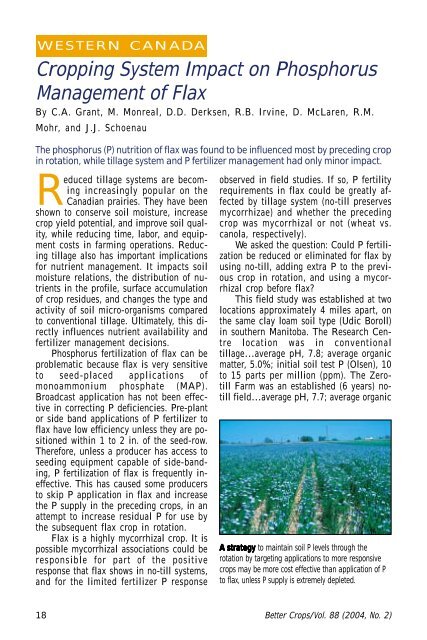Better Crops 2004 #2 - International Plant Nutrition Institute
Better Crops 2004 #2 - International Plant Nutrition Institute
Better Crops 2004 #2 - International Plant Nutrition Institute
You also want an ePaper? Increase the reach of your titles
YUMPU automatically turns print PDFs into web optimized ePapers that Google loves.
WESTERN CANADA<br />
Cropping System Impact on Phosphorus<br />
Management of Flax<br />
By C.A. Grant, M. Monreal, D.D. Derksen, R.B. Irvine, D. McLaren, R.M.<br />
Mohr, and J.J. Schoenau<br />
The phosphorus (P) nutrition of flax was found to be influenced most by preceding crop<br />
in rotation, while tillage system and P fertilizer management had only minor impact.<br />
Reduced tillage systems are becoming<br />
increasingly popular on the<br />
Canadian prairies. They have been<br />
shown to conserve soil moisture, increase<br />
crop yield potential, and improve soil quality,<br />
while reducing time, labor, and equipment<br />
costs in farming operations. Reducing<br />
tillage also has important implications<br />
for nutrient management. It impacts soil<br />
moisture relations, the distribution of nutrients<br />
in the profile, surface accumulation<br />
of crop residues, and changes the type and<br />
activity of soil micro-organisms compared<br />
to conventional tillage. Ultimately, this directly<br />
influences nutrient availability and<br />
fertilizer management decisions.<br />
Phosphorus fertilization of flax can be<br />
problematic because flax is very sensitive<br />
to seed-placed applications of<br />
monoammonium phosphate (MAP).<br />
Broadcast application has not been effective<br />
in correcting P deficiencies. Pre-plant<br />
or side band applications of P fertilizer to<br />
flax have low efficiency unless they are positioned<br />
within 1 to 2 in. of the seed-row.<br />
Therefore, unless a producer has access to<br />
seeding equipment capable of side-banding,<br />
P fertilization of flax is frequently ineffective.<br />
This has caused some producers<br />
to skip P application in flax and increase<br />
the P supply in the preceding crops, in an<br />
attempt to increase residual P for use by<br />
the subsequent flax crop in rotation.<br />
Flax is a highly mycorrhizal crop. It is<br />
possible mycorrhizal associations could be<br />
responsible for part of the positive<br />
response that flax shows in no-till systems,<br />
and for the limited fertilizer P response<br />
observed in field studies. If so, P fertility<br />
requirements in flax could be greatly affected<br />
by tillage system (no-till preserves<br />
mycorrhizae) and whether the preceding<br />
crop was mycorrhizal or not (wheat vs.<br />
canola, respectively).<br />
We asked the question: Could P fertilization<br />
be reduced or eliminated for flax by<br />
using no-till, adding extra P to the previous<br />
crop in rotation, and using a mycorrhizal<br />
crop before flax?<br />
This field study was established at two<br />
locations approximately 4 miles apart, on<br />
the same clay loam soil type (Udic Boroll)<br />
in southern Manitoba. The Research Centre<br />
location was in conventional<br />
tillage…average pH, 7.8; average organic<br />
matter, 5.0%; initial soil test P (Olsen), 10<br />
to 15 parts per million (ppm). The Zerotill<br />
Farm was an established (6 years) notill<br />
field…average pH, 7.7; average organic<br />
A strategy to maintain soil P levels through the<br />
rotation by targeting applications to more responsive<br />
crops may be more cost effective than application of P<br />
to flax, unless P supply is extremely depleted.<br />
18 <strong>Better</strong> <strong>Crops</strong>/Vol. 88 (<strong>2004</strong>, No. 2)

















